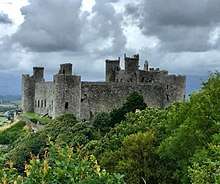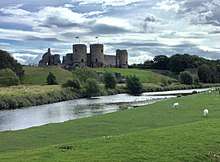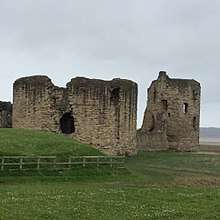Savoyard knights in the service of Edward I

The County of Savoy and the Plantaganet monarchy of England had been linked by the marriage of Henry III of England and Eleanor of Provence in 1236. Eleanor of Provence was the daughter of Beatrice of Savoy.
In 1252 Peter I, Count of Savoy introduced the son of Peter, Lord of Grandson to the English Court, Otto de Grandson. The young Otto became a childhood friend of the young English Prince Edward, later to become King Edward I. In 1268 both prince and servant were knighted and in 1271 the latter accompanied his lord on the Ninth Crusade, where he served at Acre that year. According to one source, it was Otto, not Eleanor of Castile, who sucked the poison from the wounded Edward after an attempted assassination. In 1272 Otto was appointed an executor in Acre.
Returning to England, Otto accompanied Edward in the Welsh Wars as his right-hand man, but also enlisted a whole retinue of fellow Savoyard knights in the service of the English crown. Knights from all over Savoy joined as household knights to King Edward I and were rewarded with key positions in the newly conquered Welsh lands.
Sir John de Bonvillars
Sir John de Bonvillars[1] from Bonvillars close to Grandson, he was brother in law to Otto de Grandson. Knight of King Edward I’s household and deputy Welsh Justicier to Otto from 1284 to 1287. On 2 April 1277 he was bearer of a letter to Otto who was besieging Dolforwyn Castle.[2] Was at Chester in September 1277. Revisited Savoy in 1278, was at Evian on 22 March. With Otto de Grandson in Wales in 1282 when latter was commanding forces based on Montgomery. In 1283 was sent to Wales, in 1284 he was described as Otto’s Knight Companion. Oversaw the construction of Conwy Castle.[3] First Constable of Harlech Castle[4] from 1285 to his death by drowning (probably during the siege of Dryslwyn in South Wales) between July and November 1287. Married to Agnes de Bevillard (likely sister of Otto de Grandson) who held on to the Constable of Harlech role until succeeded by Master James of Savoy in 1290.
Sir William de Cicon
From Vanclans, 24 kilometres north of Pontarlier in the Jura. Introduced to King Edwards service by Otto de Grandson. First mentioned 13 November 1276 when he comes to England with a message from Otto de Grandson to King Edward I.[5] With the army in South Wales in 1277. Constable of Rhuddlan Castle[6] between February 1282 and May 1284 including the period of the Siege of Rhuddlan. First Constable of Conwy Castle from its construction until his death in 1310 or 1311.[7]
Sir Gerard de St Laurent
Named for St Laurent of Jura. With King Edward I and Otto de Grandson on Crusade, in Acre from 1271 to 1272. One of King Edward I’s inner circle. First Constable of Flint Castle from 1277 to 1281.[8] Died in 1282 possibly in the Welsh attack on the Castle. Had been in Chillon during the 1260s.[9]
Sir Guillaume de Grandson
Brother of Otto de Grandson, he was in the service of Edmund, Earl of Lancaster, who, on his behalf sent a letter to the king (when Guillaume's lands were seized, he being an alien), pointing out the undesirability of such seizures. He succeeded Sir John de Bonvillars as Deputy Justicier of Wales in 1288, serving as his brother's deputy until 1295. On 4 Nov 1288, he had letters of protection when remaining in Wales in order to fortify the castle of Caernarfon. He supervised construction of the castle at Caernarfon. He was summoned to Parliament from 6 Feb 1298/99 to Oct 1325, whereby he is held to have become Lord Grandison, he died in 1335.
Sir Stephen de Rognon
Brother of Sir William de Cicon, was knighted by King Edward I in Wales in 1284.[10]
Summary
Along with Otto de Grandson the Savoyard knights of King Edward I of England fulfilled the roles of Justiciar of Wales, Deputy Justiciar of Wales, Constable of Flint Castle, Constable of Rhuddlan Castle, Constable of Conwy Castle and Constable of Harlech Castle.
References
- ↑ His name is sometimes spelt Jean de Benvillard after the gallicised (French) form.
- ↑ Taylor, A.J. (1963) "Some notes on the Savoyards in North Wales, 1277-1300. With special reference to the Savoyard element in the construction of Harlech Castle". Genava 11: 290-291.
- ↑ A.J. Taylor The Welsh Castles of Edward I, The Hambledon Press. London, 1986 pp. 49-50.
- ↑ A.J. Taylor The Welsh Castles of Edward I, The Hambledon Press. London, 1986 pp. 69
- ↑ Taylor, A.J. (1963) "Some notes on the Savoyards in North Wales, 1277-1300. With special reference to the Savoyard element in the construction of Harlech Castle". Genava 11: 290-291.
- ↑ A.J. Taylor The Welsh Castles of Edward I, The Hambledon Press. London, 1986 pp. 32.
- ↑ A.J. Taylor The Welsh Castles of Edward I, The Hambledon Press. London, 1986 pp. 50.
- ↑ A.J. Taylor The Welsh Castles of Edward I, The Hambledon Press. London, 1986 pp. 25.
- ↑ Taylor, A.J. (1963) "Some notes on the Savoyards in North Wales, 1277-1300. With special reference to the Savoyard element in the construction of Harlech Castle". Genava 11: 290-291.
- ↑ Taylor, A.J. (1963) "Some notes on the Savoyards in North Wales, 1277-1300. With special reference to the Savoyard element in the construction of Harlech Castle". Genava 11: 290-291.



